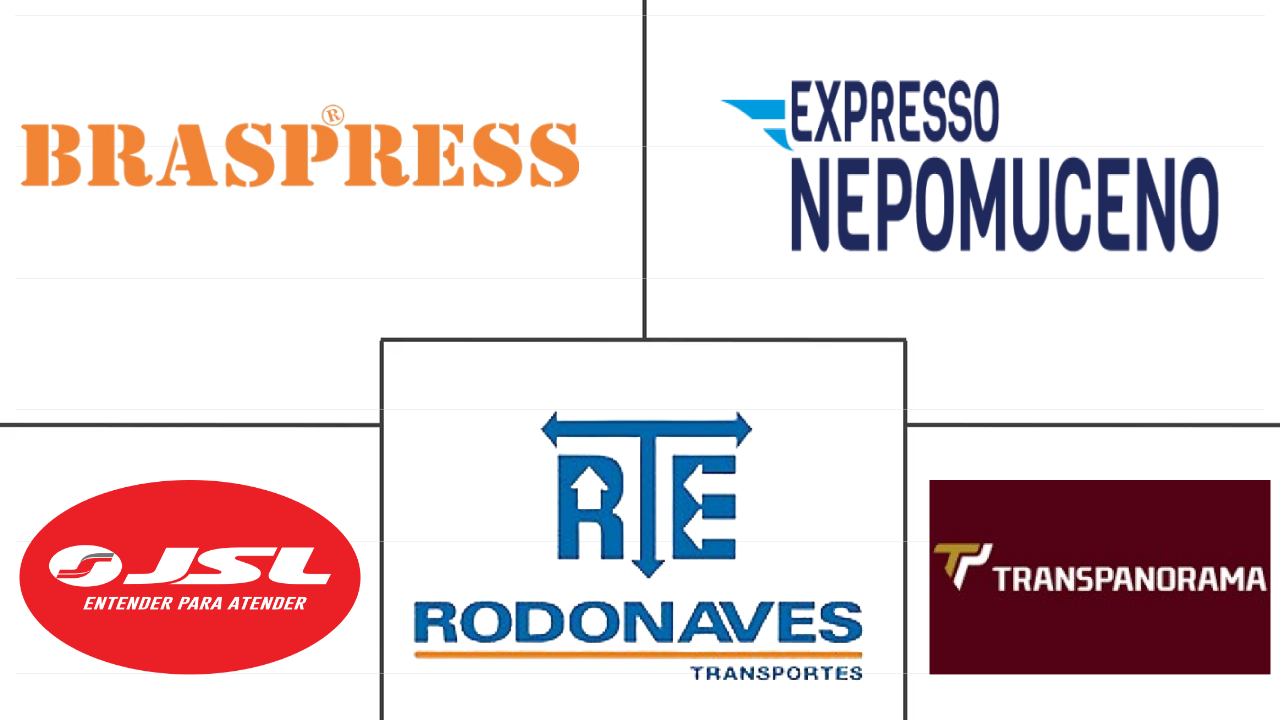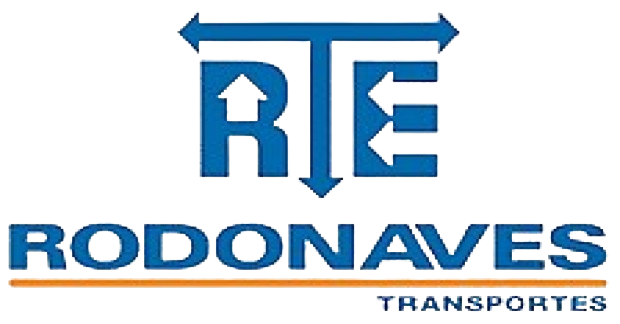Market Size of brazil road freight transport Industry
|
|
Study Period | 2017 - 2030 |
|
|
Market Size (2024) | USD 42.87 Billion |
|
|
Market Size (2030) | USD 56.55 Billion |
|
|
Largest Share by End User Industry | Manufacturing |
|
|
CAGR (2024 - 2030) | 4.72 % |
|
|
Fastest Growing by End User Industry | Wholesale and Retail Trade |
Major Players |
||

|
||
|
*Disclaimer: Major Players sorted in no particular order |
Brazil Road Freight Transport Market Analysis
The Brazil Road Freight Transport Market size is estimated at 42.87 billion USD in 2024, and is expected to reach 56.55 billion USD by 2030, growing at a CAGR of 4.72% during the forecast period (2024-2030).
42.87 Billion
Market Size in 2024 (USD)
56.55 Billion
Market Size in 2030 (USD)
3.21 %
CAGR (2017-2023)
4.72 %
CAGR (2024-2030)
Largest Market by Distance
75.37 %
value share, Long Haul, 2023
Long-haul trucking is significant to the Brazilian economy due to the growing trade and cross-border freight transport in the country.
Largest Market by Goods Configuration
71.08 %
value share, Solid Goods, 2023
With substantial investments in consumer and industrial products, the solid goods segment accounts for the highest market share as the industries under this category account for the most goods transported.
Largest Market by End User Industry
42.39 %
value share, Manufacturing, 2023
The manufacturing segment contributed around 11.30% to the GDP in 2022. The sector is expected to contribute even more over the coming years due to the implementation of Industry 4.0 technologies.
Fastest Growing Market by Truckload Specification
5.29 %
Projected CAGR, Less than-Truck-Load (LTL), 2024-2030
A growing demand for online goods generates significant demand for LTL trucking. The number of online shoppers increased by 24% YoY in 2022 and reached 108.9 million.
First Leading Market Player
1.87 %
market share, RTE Rodonaves, 2022

Grupo Rodonaves provides road freight services with its subsidiary, RTE Rodonave. The company provides services to 5,000 cities across Brazil through its 300 units.
E-commerce industry’s impressive 26% growth set to catalyze Brazil's economy
- In the Brazilian economy, manufacturing is the major contributing sector. Among the various product-based industries in the manufacturing sector, material products hold the largest revenue share of 51.03%. It is followed by consumer products with a share of 30.12% and automotive products with a share of 7.78%. The primary categories driving growth in these industries are automobiles, trailers, vehicle bodies, machinery and equipment, and metallurgy. In addition, the automotive industry produced 2,204,000 automobiles and light commercial vehicles in 2023, just 1.3% growth over 2022.
- E-commerce is one of the largest growing industries in Brazil. The country is one of Latin America's most advanced e-commerce markets, with online shopping accounting for 17% of consumers' consumption. E-commerce sales increased by 26.5% in Brazil in 2021 and reached USD 37.5 billion. Almost 13 million new consumers started buying online, creating a total of 87.7 million online shoppers in Brazil in 2021. In addition, e-commerce in Brazil accounted for 18% of the share of retail in 2022, while the average for Latin America was barely 8%. The e-commerce market in Brazil is expected to grow at a CAGR of 14% during the period 2023-2027.
- Mercado Libre, the world's largest e-commerce company, announced a record USD 3.6 billion investment in Brazil, with its fintech business serving as one of the engines of growth in Latin America's largest economy. Mercado Libre, which has a market capitalization of USD 60 billion and trades in US markets, had announced plans to invest BRL 19 billion (USD 3.6 billion) in 2023 to expand its business in Brazil. The Argentine company has expanded beyond its home country, where it has a monopoly, to gain a stake in other regional economies.
Brazil Road Freight Transport Industry Segmentation
Agriculture, Fishing, and Forestry, Construction, Manufacturing, Oil and Gas, Mining and Quarrying, Wholesale and Retail Trade, Others are covered as segments by End User Industry. Domestic, International are covered as segments by Destination. Full-Truck-Load (FTL), Less than-Truck-Load (LTL) are covered as segments by Truckload Specification. Containerized, Non-Containerized are covered as segments by Containerization. Long Haul, Short Haul are covered as segments by Distance. Fluid Goods, Solid Goods are covered as segments by Goods Configuration. Non-Temperature Controlled, Temperature Controlled are covered as segments by Temperature Control.
- In the Brazilian economy, manufacturing is the major contributing sector. Among the various product-based industries in the manufacturing sector, material products hold the largest revenue share of 51.03%. It is followed by consumer products with a share of 30.12% and automotive products with a share of 7.78%. The primary categories driving growth in these industries are automobiles, trailers, vehicle bodies, machinery and equipment, and metallurgy. In addition, the automotive industry produced 2,204,000 automobiles and light commercial vehicles in 2023, just 1.3% growth over 2022.
- E-commerce is one of the largest growing industries in Brazil. The country is one of Latin America's most advanced e-commerce markets, with online shopping accounting for 17% of consumers' consumption. E-commerce sales increased by 26.5% in Brazil in 2021 and reached USD 37.5 billion. Almost 13 million new consumers started buying online, creating a total of 87.7 million online shoppers in Brazil in 2021. In addition, e-commerce in Brazil accounted for 18% of the share of retail in 2022, while the average for Latin America was barely 8%. The e-commerce market in Brazil is expected to grow at a CAGR of 14% during the period 2023-2027.
- Mercado Libre, the world's largest e-commerce company, announced a record USD 3.6 billion investment in Brazil, with its fintech business serving as one of the engines of growth in Latin America's largest economy. Mercado Libre, which has a market capitalization of USD 60 billion and trades in US markets, had announced plans to invest BRL 19 billion (USD 3.6 billion) in 2023 to expand its business in Brazil. The Argentine company has expanded beyond its home country, where it has a monopoly, to gain a stake in other regional economies.
| End User Industry | |
| Agriculture, Fishing, and Forestry | |
| Construction | |
| Manufacturing | |
| Oil and Gas, Mining and Quarrying | |
| Wholesale and Retail Trade | |
| Others |
| Destination | |
| Domestic | |
| International |
| Truckload Specification | |
| Full-Truck-Load (FTL) | |
| Less than-Truck-Load (LTL) |
| Containerization | |
| Containerized | |
| Non-Containerized |
| Distance | |
| Long Haul | |
| Short Haul |
| Goods Configuration | |
| Fluid Goods | |
| Solid Goods |
| Temperature Control | |
| Non-Temperature Controlled | |
| Temperature Controlled |
Brazil Road Freight Transport Market Size Summary
The Brazil Road Freight Transport Market is poised for significant growth, driven by the country's robust manufacturing and burgeoning e-commerce sectors. Manufacturing, particularly in material products, consumer goods, and automotive sectors, plays a pivotal role in the economy, with key industries such as automobiles, machinery, and metallurgy propelling demand for road freight services. The e-commerce sector, one of the fastest-growing industries in Brazil, has seen a substantial increase in online shopping, further boosting the need for efficient logistics and transportation solutions. Despite the challenges posed by inadequate infrastructure and high logistics costs, the market is expected to expand steadily over the forecast period, supported by government initiatives and private investments aimed at enhancing transportation infrastructure.
The Brazilian government's efforts to privatize and reform logistics infrastructure are central to addressing the country's significant infrastructure funding gap. These initiatives include concession auctions and regulatory changes to attract foreign investment in railways, airports, highways, and ports. The market is characterized by a fragmented landscape, with major players like Braspress, Expresso Nepomuceno, JSL SA, RTE Rodonaves, and Transpanorama Transportes LTDA holding a modest share. Additionally, the market is witnessing innovations such as the introduction of electric and multi-temperature vehicles, reflecting a broader commitment to sustainability and efficiency in logistics operations. Despite challenges like fluctuating fuel prices and economic volatility, the market's growth trajectory remains positive, driven by strategic investments and technological advancements.
Brazil Road Freight Transport Market Size - Table of Contents
-
1. MARKET SEGMENTATION (includes market size in Value in USD, Forecasts up to 2030 and analysis of growth prospects)
-
1.1 End User Industry
-
1.1.1 Agriculture, Fishing, and Forestry
-
1.1.2 Construction
-
1.1.3 Manufacturing
-
1.1.4 Oil and Gas, Mining and Quarrying
-
1.1.5 Wholesale and Retail Trade
-
1.1.6 Others
-
-
1.2 Destination
-
1.2.1 Domestic
-
1.2.2 International
-
-
1.3 Truckload Specification
-
1.3.1 Full-Truck-Load (FTL)
-
1.3.2 Less than-Truck-Load (LTL)
-
-
1.4 Containerization
-
1.4.1 Containerized
-
1.4.2 Non-Containerized
-
-
1.5 Distance
-
1.5.1 Long Haul
-
1.5.2 Short Haul
-
-
1.6 Goods Configuration
-
1.6.1 Fluid Goods
-
1.6.2 Solid Goods
-
-
1.7 Temperature Control
-
1.7.1 Non-Temperature Controlled
-
1.7.2 Temperature Controlled
-
-
Brazil Road Freight Transport Market Size FAQs
How big is the Brazil Road Freight Transport Market?
The Brazil Road Freight Transport Market size is expected to reach USD 42.87 billion in 2024 and grow at a CAGR of 4.72% to reach USD 56.55 billion by 2030.
What is the current Brazil Road Freight Transport Market size?
In 2024, the Brazil Road Freight Transport Market size is expected to reach USD 42.87 billion.

